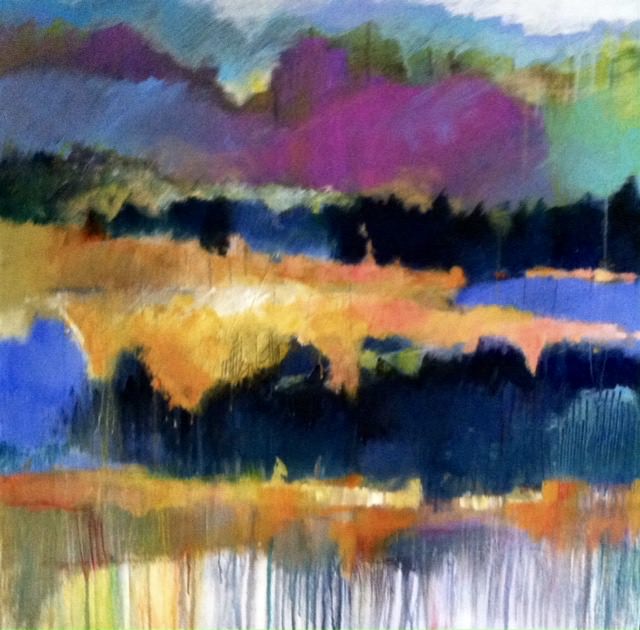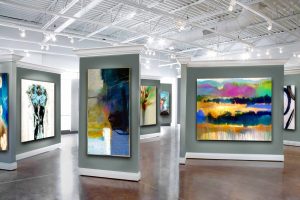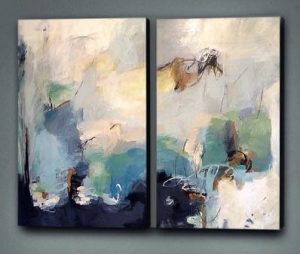Good lighting will dramatically improve the impact of original art and bring out its true colors. Your painting will “pop!” The subject is seemingly simple, but there are some complexities.
There are essentially two options, each with its own pros and cons:
• Install lighting fixtures in the ceiling; or
• Install a picture light that attaches to the back of the frame.
Ceiling lighting is clearly the preferred method in terms of the quality of lighting, but it’s not always feasible, particularly in rooms with high ceilings or rooms where getting power to ceiling lights is not practical. If it’s possible for one to go this route, there are several variables, each with installation preferences.
• The optimum distance “cans” should be placed from the wall depends in part on how much relief exists on the frame. The idea is to avoid shadows created by the upper rail of the frame. Generally, try to error on the side of having the lights further away from the wall…at least 24”.
• We recommend using TWO adjustable, hooded fixtures, each pointed at a spot about one-third in from each vertical edge of the painting, so the two light beams overlap. Our experience is that one light just doesn’t get it done, especially for a wide painting.
• For light bulbs, we recommend using 50-watt, MR-16’s, i.e. low voltage, high intensity bulbs. If you already have cans installed employing conventional “line voltage,” they will work just fine. Do NOT let anyone talk you into LED bulbs. The technology has not advanced enough to produce sufficient intensity, even the new 10-watt bulbs that are supposed to replicate 50+ wattage.
• Within the category of light bulbs, particularly MR-16’s, there are two further options…the size of the beam (measured in degrees) and the whiteness of the light (measured on a “Kelvin” scale).
◦ We generally recommend a broader beam (i.e. the size of the light cone). Beams range from 15 degrees to 38 degrees. The optimum beam depends on the distance from the light to the painting, but error on the side of a broader beam.
◦ We strongly recommend “Kelvin” ratings on the bulbs of 3500-4000 or more. This is a very white light (unlike most household bulbs that have a yellow cast, i.e. a 2200-2500 Kelvin rating), which is perfect for illuminating art.
• Finally, insist on an independent wall switch (with dimmer), so the lighting for your painting is not dependent upon the lighting in the rest of the room.
Picture Lights are an effective option and are often the only practical solution. Again… there are several options/considerations.
• We strongly recommend the House of Troy in Vermont. They make very high quality fixtures with impeccable finishes. We use their “Slimline” line of plug-in picture lights almost exclusively. It’s a very clean, attractive fixture and doesn’t interfere with the impact of the painting.
• The width of the fixture should be roughly two-thirds the width of your painting. In some cases, if your painting is too wide, you may require two fixtures.
• Several colors/finishes are available. The idea is to have the fixture coordinate with other finishes in the room and blend nicely into the upper rail of the frame, both from a color and a height perspective. The height of the light can be adjusted up or down (easy to do with adjustable set screws on the back).
• Some words of caution on picture lights…
• You will need to install a recessed duplex plug behind the painting. This avoids having a chord dangling down below the painting to the wall plug. Any electrician can install this plug fairly easily, particularly if there are duplex plugs already installed near the bottom of the same wall.
• Again, insist on an independent wall switch with dimmer. Picture lights come with a built-in on/off switch, but they’re a pain to use and can’t be hidden easily behind the painting without creating an obstruction that prevents the painting from hanging flat.
• Do NOT let anyone talk you into battery-operated lights. The batteries need to be replaced constantly.
If you decide to go with a picture light, we can help determine the best size/color and order one for you. They’re not inexpensive ($300-$400), but they are magnificent fixtures that will last forever.
To discuss your lighting options, please call or visit Art Post Gallery. It’s an important part of creating real “impact” with your original art and an area of expertise that distinguishes us as one of the best art galleries in Chicago and the Chicagoland area.




